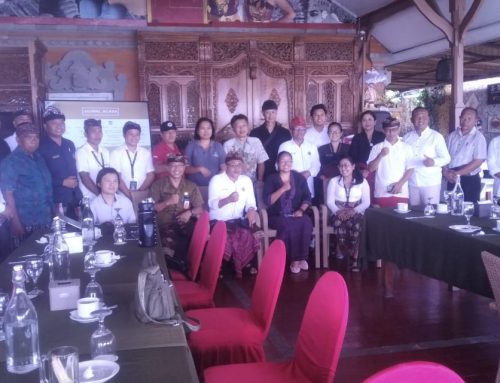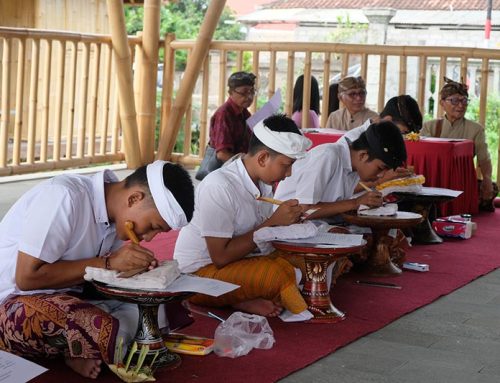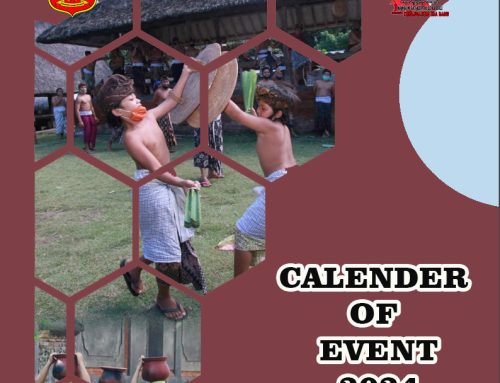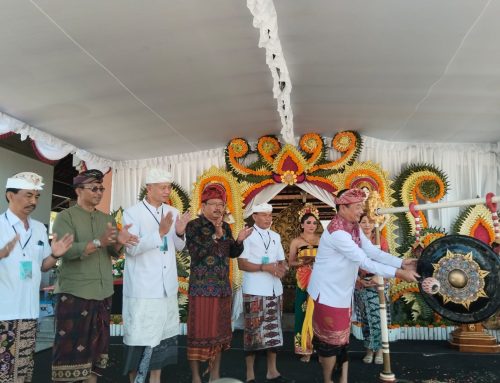PREFACE
Salak or snake skin fruits are typical produce of Kabupaten (Regency of) Karangasem, very well liked by the Balinese people themselves as well as outsiders so that they have a prospective marketable commodity.
The Introducing Agrotourism: Skin Snake Fruits of Sibetan is a comprehensive source of information on this special fruit of Sibetan village in Karangasem Regency. The publication is aimed at introducing Balinese Salak (skin snake fruit) to the general public.
I believe that this book cannot tell the reader every thing about this fruit, as there are many other relevant information which cannot be included here. Therefore, I would like to recommend that a visit to the area to taste and have hands on experience about this unique fruit is worth doing.
I sincerely hope that this small book can a good source of information for many different reasons.
Amlapura, 10 January 2000
Karangasem Government Tourism Office
Drs. I Made Bagiada
INTRODUCTION
Salak is a tropical fruit generally found all over Indonesia available in many different areas and are named in accordance with its place of origin, for example, Salak Pondoh, Salak Madura, Salak Rondet and Salak Bali.
Salaks belong to a horticultural variety of fruit with its prospective business opportunity for cultivation. People love Salak Bali in particular including domestic people as well as foreigners implying that Salaks has a great market opportunity.
The biggest Salak Bali producing area is the village of Sibetan in Kecamatan Bebandem, Kabupaten Karangasem. Salaks from Sibetan have the following out standing characteristics.
- It belongs to monocle family with no category of male or female groups.
- It has complete flowers where pollination takes place the flowers blooms and therefore they do need the assistance of pollinating agents such as insects, nature, or human being for pollination.
- They have thick white, crunchy flesh with low tamine contens and sweet nice taste.
- The flesh can be processed into various cookies such as: taffy food salak, sweets and syrups.
SIBETAN IN BRIEF
The village of Sibetan is located in Kecamatan Bebandem, Kabupaten Karangasem or approximately 83 Km east of Denpasar, the capital of Bali or 15 Km from Amlapura, the capital of Karangasem. The village covers an area of 11.25 Km2Â with the following boundaries.
- To the North       : Jungutan village of Kecamatan Bebandem
- To the East        : Bebandem village of Kecamatan Bebandem
- To the South       : Selumbung and Manggis villages of Kecamatan Manggis
- To the West       : Duda Timur village of Kecamatan Selat
Administratively, the village of Sibetan consists of 12 Dusun/Banjars (Community Groups) with a population of 8,271 people who are mostly Balinese Hindus. Farming is the job of the majority people.
Sibetan is economically and strategically located as it is closed to the capital city of the regency, Amlapura. It is also closed to Semarapura, the capital of Kabupaten Klungkung and Gianyar. Transport facility is very good as the village is connected by the main road connecting Amlapura – Sidemen – Rendang – Besakih.
The weather is fresh and cool with a spectacular view of Mt Agung to the north, the highest mountain in Bali where the mother temple of Besakih is located. To the south is a beautiful view of mountains stretching along Kecamatan Manggis, Padangbai and end to the blue sea of Lombok Strait. Considering all these geograhical conditions, Sibetan could make a good tour package that includes the following aspects.
- Agrotourism to intoduce agroindustry as the main attraction.
- Natural tours to introduce a tour package in corporating natural beauty the main attraction.
These two tour packages have a reciprocal effects of environmental awareness programs and agriculture so that salaks and other fruits could have their marketing potentials.
SALAK CULTIVATION
Salaks grow very well in sandy fertile farming areas with a high rainfall rate. It is still all right the rain fall is low as long as there is a shallow potential of ground water.
Salaks in Sibetan has been known since a hundred years ago during which they grew naturally in the wild. In 1980 the farmers of Sibetan collectively cultivate salaks. Nowadays, there are some other villages, e.g., Selat, Sidemen and Rendang, trying to imitate what Sibetan farmers have done.
However, compared to salaks produced in other villages, the ones from Sibetan are the best quality.
You will finds salaks plantation which is a hundred years old. These old salak tree are characterised by horizontal trunks, the stumps are lifted on the ground while their hairy roots emerge from the trunks hanging down penetrating the ground so that it looks like a dragon.
In order to obtain the best quality salaks, the following traditional methods are a common practice of Sibetan farmers.
Seedling preparation
- Seedling preparation is done by buring seeds under the ground. This method allows farmers to plant seeds in a large quantity.
- Area preparation
- One year prior to plantation, the area has to be cleared and planted with other trees for shading purposes using dadap, turi, lamtoro or gamal trees.
- Holes are prepared one month in advance prior to planting. The holes are made in certain dimentions and filled in with compost and sandy earth.
- Plantation
- Planting is conducted one month after the holes are filled in with compost.
- The trees to be planted should be 4 – 6 months old or the ones with 3 – 5 leaves.
- Planting is best conducted at the beginning of the rainy season.
- Maintenance
- Salak plantations should be well maintained from the day of planting until all the trees bear fruits including:
- Weeding out.
- Use of compost or fertilizers.
- Well managed pest control programs until now, farmers have not identified typical salaks pests.
- Harvest
- There are two kinds of harvest of Sibetan salaks as follows.
- Natural harvest season is conducted from January to March every year. Salaks harvested at this time are big and sweet.
- Gadon harvest is performed from August – September every year when salak trees produce rat her smaller fruit size. Although there are two harvests in a year, salaks are available in Sibetan through out the year.
- Type of Salaks
- Salak Gondok, with the following characteristics;
- Round fruit.
- Brown skin.
- Yellowish thick flesh.
- Sweet.
- Small kernel.
- Salak Nenas, with the following characteristics;
- Fruits and skin similar to Salak Gondok.
- Whiter flesh.
- More sweet with a little bit sour.
- Thick and juicy flesh.
- Salak Gula pasir, with the following characteristics;
- Similar fruit.
- Dark brown skin.
- White flesh.
- Very sweet.
- Salak Nangka, with the following characteristics;
- Big brown-yellowish fruit.
- Yellowish flesh smells like jack fruit.
- Sweet flesh.
- Thick juicy flesh.
- Salak Kelapa, with the following characteristics;
- Round.
- Brown-reddish skin.
- More sweet than Salak Nanas.
- Salak Injin, with the following characteristics;
- Skin and fruit similar to Salak Nanas.
- Back stripes on flesh.
- Salak Gading, with the following characteristics;
- Shape and size similar to Salak Nanas.
- White yellowish skin.
- Not very sweet.
- Salak Embadan/ Raja, with the following characteristics;
- Similar to Salak Nangka.
- More juicy flesh.
- Salak Getih, with the following characteristics;
- Similar to other salaks.
- Blackish skin on the tips.
- Bigger than Salak Gula Pasir.
- Red flesh.
- Sweet and fresh.
- Salak Cengkeh, with the following characteristics;
- Small fruit.
- Sweet, a little hot and smell like clove.
- Salak Bingin, with the following characteristics;
- Curly leaves like that of a banyantree.
- Rare fruit.
- Salak Mesui, with the following characteristics;
- Similar to Salak Gondok.
- Sweet and smell like mesui (a kind of herb).
- Salak with white kernel, with the following characteristics;
- Similar size to Salak Nangka.
- Astringent to the taste.
- White kernel.
- Salak Meong, with the following characteristics;
- Same size as other salaks.
- White spots.
- Salak Penyalin, with the following characteristics;
- Same size as salak Kelapa.
- Astringent to the taste.
Â
SALAK PROCESSING
      Salak can be processed into the following food.
- Taffy salaks.
- Sweets.
- Syrups.
- Salted fruits.
MARKETING
Salak cosumers consist of domestic and foreign people but its marketing is limited to domestic market. The fruit is also exported to other regions or islands throughout the country. In Sibetan it self, there two markets, i.e. Telaga and Kalanganyar markets where people can buy salaks. The nearby market is in Bebandem and Pesangkan public markets. In addition, there are a number of local exporters who sell the fruit throughout Indonesia.








Leave A Comment